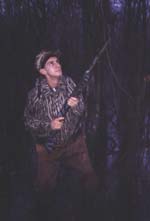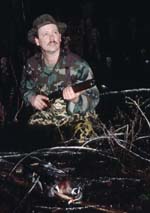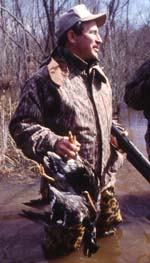
|
Features
|
|
|
|
Book Selections
|
|
Fun & Games
|
|
Contact Us
|
Early Americans saw the sport of duck hunting quite differently from how we view it today. In the days of the Pilgrims, an estimated 1/2-billion ducks inhabited America. Duck hunting involved no sport. The meat provided vittles,and you bagged them any way you could. Here's some tactics for taking ducks.
STALKING DUCKS-- Many of the early outdoorsmen stalk-hunted ducks. I stumbled onto the productivity of stalking ducks quite by accident a few years back.
At that time I hunted a swamp full of water. For three days, the rains had soaked the land. The woods looked more like a creek than a hardwood bottom. As I slipped down a logging road stalking squirrels with my 12-gauge rifle, I heard the whistling and splashing of wood ducks as they came in to the bottom to feed.
I had worn my Red Ball Flyweight waders that morning knowing that when I shot a squirrel, it probably would land in the water. Sure enough, I had several wet retrieves. After thinking about waterfowl for supper and having taken three more squirrels for a limit, I decided to try and stalk ducks.
As I entered the water, I noticed the waves leaving my knees and forming ringlets out in front of me.
"Uh-oh, a duck will be able to see that," I told myself. "Those waves may spook the flock."
I slowed my pace and carefully kept the disturbance on the water to a minimum. I first saw the ducks at about 150 yards through the flooded timber. At that distance, I could not tell how many held there. But I could pinpoint their exact location. As I crept through the water, I kept trees between me and my quarry. I also checked my watch to time my progress.
I kept telling myself, "You have all day to get to the ducks. If you hurry or if you make a mistake, you'll blow the entire stalk."
One hour and 15 minutes later, I stood within 50 yards of the woodies. I carefully selected which tree to move to next as I worked my way closer to the ducks. I could hear the quacks clearly now.
Unfortunately the mental games started with me that happen to every hunter. I began thinking ... ..."Can I get any closer?" ..."Should I try for a shot now?" ..."If I try to move in closer, will I spook the ducks and not get a shot?"
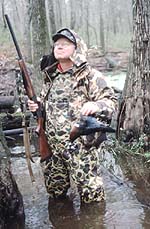 I
convinced myself that my goal was a giant water oak 20 yards from the
ducks. "If I can get to the water oak, I can get ready, move from behind
the tree and take the ducks when they jump."
I
convinced myself that my goal was a giant water oak 20 yards from the
ducks. "If I can get to the water oak, I can get ready, move from behind
the tree and take the ducks when they jump."
I constantly had to keep reminding myself to go slowly, take my time, decide when and where to take every step and very carefully choose each tree I hid behind. By now the quacking, whistling and splashing of the ducks deafened me. Finally, after one hour and 45 minutes of snaking my way through the flooded timber, I arrived at my destination, the big water oak.
In the meantime, the ducks had flown toward my hiding tree -- 15 to 20 yards in front of me. I took a minute to check my safety and prepare for my shot. About 15 woodies rafted on the water. When I moved from behind the tree, the ducks jumped. The air immediately filled with feathers and the smoke frommy gun.
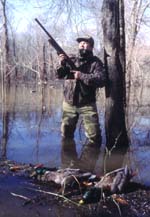 "Shoot
over the woodies," my brain relayed to me after my first shot missed.
"Shoot
over the woodies," my brain relayed to me after my first shot missed.
My next two shots brought two colorful males tumbling from the sky. As the ducks vanished into the deep woods, I sighed in relief and unknotted my muscles. My long and tedious stalk had paid off.
For a moment I enjoyed the peacefulness of the scene. Then I heard the wings of a woodie. Looking skyward, I saw another duck side-stepping trees and fluttering down right in front of me. While I mounted my gun, the woodie had all gears in reverse. My gun proved its value once again as I downed the duck. Stalk hunting flooded timber yielded a limit of ducks for me.
Two hunters can stalk the same flock by staying 20 yards apart. Allow only one hunter at a time to move to reduce the likelihood of the ducks' seeing you. Utilize hand signals between the two hunters to signify ... * when to move, * when and where to stop, * where the ducks are, * when to get ready to shoot and * when to flush the birds.
In another technique for tandem stalking, one hunter comes in from behind the ducks, while the other hunter moves in from the front. Using this approach, only one hunter shoots.
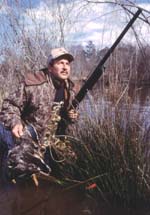 Let
the ducks get into the air. Only shoot at treetop level to prevent the
two of you from aiming at one another. Don't use this method unless you've
hunted with each other for some time and have total trust in one another
to hold your shots until you have a safe position from which to shoot,
and the ducks are well in the air. The novice hunter or shooter should
not utilize this strategy.
Let
the ducks get into the air. Only shoot at treetop level to prevent the
two of you from aiming at one another. Don't use this method unless you've
hunted with each other for some time and have total trust in one another
to hold your shots until you have a safe position from which to shoot,
and the ducks are well in the air. The novice hunter or shooter should
not utilize this strategy.
Hang-Over Ducks
My brother, Archie, had another stalking tactic that worked well for him. He located a feeding area along a small creek with a hill and a large overhang behind the creek. While fishing in the fall in the creek, Archie noticed that ducks often fed under the overhang.
Once waterfowl season started, Archie mapped out a game plan. By belly-crawling up to the edge of the overhang, he lay right above the ducks when they jumped. They would have to come out from under the ledge to escape. Then he would have an easy 10-yard shot.
Each Wednesday and Saturday evening, Archie crawled the 30 yards to the overhang. Before dark each day, he climbed down the hill and picked up his limit of ducks.
Many hunters have a difficult time stalking creek quacks. For some reason, the ducks on small creeks seem much spookier than flooded-timber ducks. Late in the season when you'll find much of the big water covered with ice, the small, free-flowing streams may home loads of ducks. But you can hardly slip up on them successfully. Unless a sportsman can find cane or briars along the bank to mask his stalk, he rarely will have success taking creek quacks from the bank by himself.
However, by cooperating with a good friend, you can remedy this problem. If you and your buddy know that waterfowl have invaded running water, then one hunter can start stalking down the creek while the other hunter stalks up the creek 1 to 3 miles. If the birds do get up wild, both hunters have a chance at some excellent pass shooting on both ends.
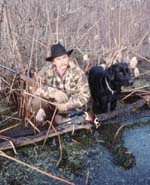 To
take creek quacks, you also can float. When ice-ups occur, the ducks have
to find open, non-iced water. The free-flowing creeks remain their best
bets. One- or two-man lightweight boats, like the Bass Hunter, the Portabote
or a canoe, make float-hunting rewarding. A meandering creek with plenty
of bends and coves works best.
To
take creek quacks, you also can float. When ice-ups occur, the ducks have
to find open, non-iced water. The free-flowing creeks remain their best
bets. One- or two-man lightweight boats, like the Bass Hunter, the Portabote
or a canoe, make float-hunting rewarding. A meandering creek with plenty
of bends and coves works best.
Often you'll hear the ducks before you get to them. As you float in front of a slough or a pocket, you only may float within 10 yards of waterfowl as your boat comes to the mouth of a pocket. This quick shooting is a snap shooter's dream.
Come Back Throughout the Week for More Free Tips...
Day One - Tolling Ducks
Day Two - Market Gunning Ducks
Day Three - Take Early 20th
Century Ducks
Day Four - Stalking Ducks
Day Five - Jump Shooting Essentials

